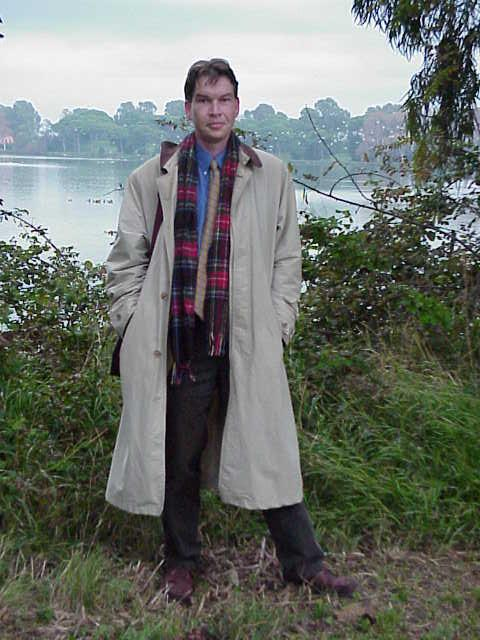
In front of Trajan's basin (November 1998).
Photo: Joanne Spurza.
Topographical dictionary - Presentation
The World Wide Web is in 1999 still an exciting tool, surrounded by question marks. A Topographical Dictionary of Ostia, presented on the Internet, is therefore both a challenge and an experiment. It deserves some comments and explanations.
My Ostian studies began in 1983 and have continued ever since. It literally took me years to get acquainted with the city. And still there are many white and grey areas in my knowledge. The quantity and diversity of the evidence pertaining to Ostia is tremendous. Indeed, few people can hope to have digested all of it at the end of a full life. I am certainly not one of the happy few. Nevertheless I have managed to convince myself that I have by now a background, which allows me to work on an outline of the city. Fortunately I will not have to do it all by myself. It will be an effort of the Internet Group Ostia. Even in the early stages of the compilation of the Dictionary help has been offered and given by friends and colleagues - or sodales (comrades, fellows, mates) as the Ostian researchers like to call themselves.
The demands of classical archaeology are formidable. In order to grasp a city like Ostia, one should be familiar with Latin, Greek, epigraphy, legal sources, architecture, the history of art, religion, geology, and so on and so forth. Archaeologists realize that an interdisciplinary effort is crucial. On the other hand, interested lay-men, students, and those who come across Ostia during their studies require an overall description, an introduction. As one sodalis once said to me: "When I started studying Ostia my first question was: 'Where to begin?'".
There are of course beginnings, and they are very good. As to the period after WW II, the work of Becatti, Meiggs, Pavolini, Boersma, Heres, and Sirks (to name but a few) is fundamental. Reading an article by Zevi or Floriani Squarciapino is a guaranteed thrill. Now what can an Internet presentation add to these wonderful efforts?
Two aspects may be highlighted.
- The content of the Internet presentation will change when new arguments are found in existing literature, or when new research has been published. A World Wide Web page can be updated with little cost. Publishing an updated version of a printed book is costly.
- On the World Wide Web there is almost no relation between money and content. Text that "would never sell" can be made available on the web. And text can be accompanied by many colour photographs, plans and reconstruction drawings. It will not make the web-pages more expensive. It would make a book unaffordable.I would like to stress that, in my view, our efforts on the web should not try to replace the traditional approach towards scientific publication. Publishing should be left to the professional editors, who know all about lay-out, graphics, and coordinating peer review.
As I have said before, I cannot hope to come to grips with all of Ostia. For this there are also practical reasons. The libraries of Leyden, The Netherlands, my university, are well-stocked, but some publications are far away, and can only be accessed by paying a lot of money. And of course it is inevitable that I will miss important contributions in general studies.
The Dictionary is intended as a first introduction, and I hope you will benefit from it. So is there nothing new in the Dictionary? Yes, there is. The Dictionary hopes to end in the twilight zone, where it has become clear what we know, and where we start to ask questions. Asking these questions will often be the result of my ignorance. But, as someone once taught me: "It is imperative to be honest about your knowledge, that is: where it ends".
Jan Theo Bakker
Leiderdorp, February 24, 1999
